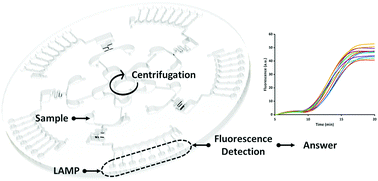An integrated microfluidic detection system for the automated and rapid diagnosis of high-risk human papillomavirus†
Abstract
Human papillomavirus (HPV) causes the prevalent sexually transmitted infection that accounts for the majority of cervical cancer incidences. Therefore, the development of a rapid, accurate, automatic and affordable nucleic acid detection strategy is urgently required for HPV tests, among which microfluidic chip is a promising diagnostic method. In this work, we developed a microfluidic detection system consisting of a microfluidic chip and the corresponding detection equipment to diagnose high-risk HPV. The proposed method integrates nucleic acid purification, isothermal amplification and real-time fluorescence detection into one device. Moreover, it demonstrates good detection performance such as high specificity of primer sets (100%) and exceptional stability (coefficient of variation <6%) among five HPV genotypes. Besides, the microfluidic loop–mediated isothermal amplification (LAMP) assay is accurate (specificity of 91.7% and sensitivity of 100%) and fast (average time threshold = 10.56 minutes) when considering the conventional qPCR assay as the gold standard. The integrated microfluidic detection system offers automated and rapid diagnosis within 40 minutes and shows broad potential to deliver point-of-care detection in resource-limited circumstances owing to its simplicity and affordability.

- This article is part of the themed collection: 150th Anniversary Collection: Microfluidics


 Please wait while we load your content...
Please wait while we load your content...